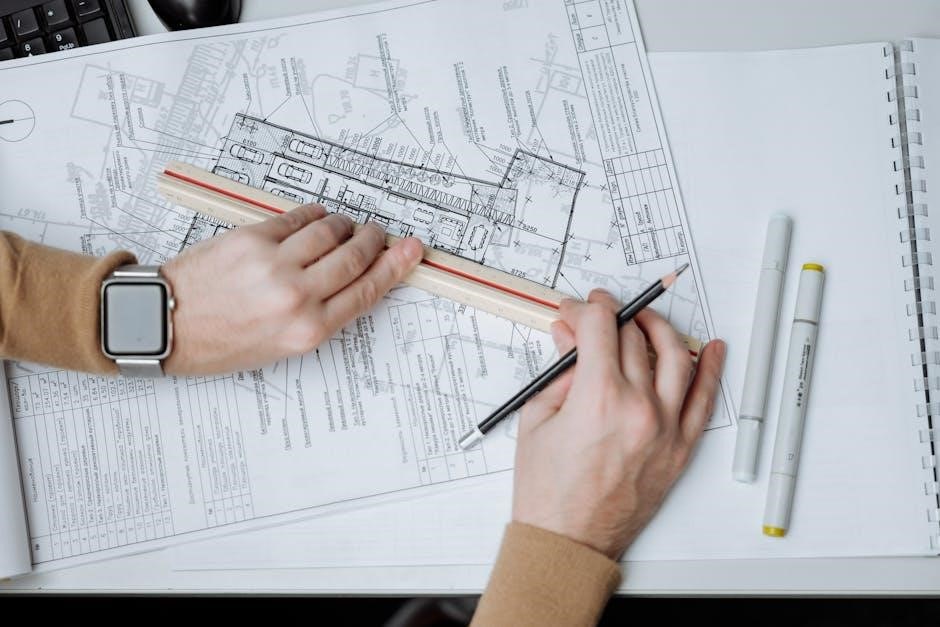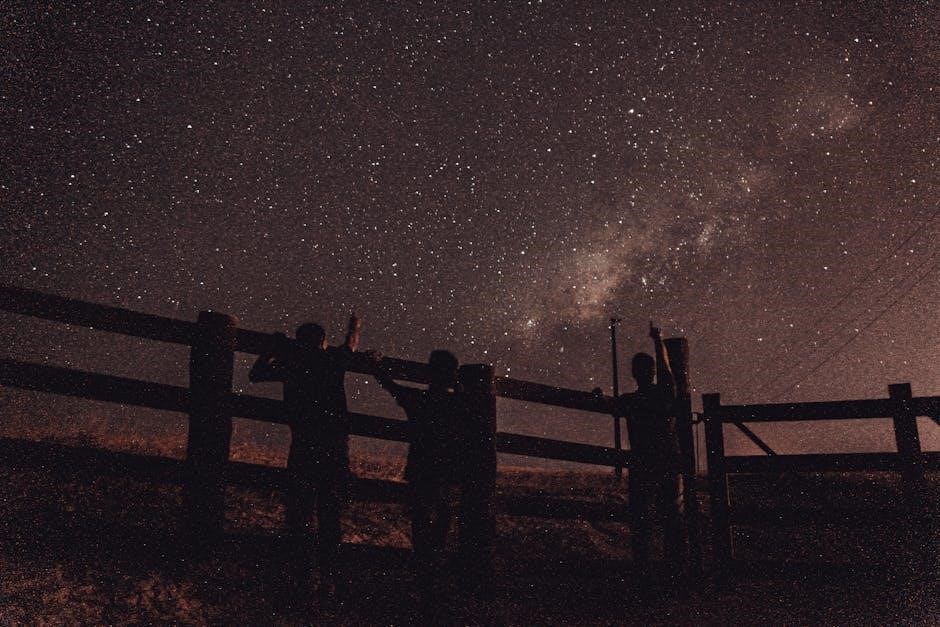The Ranchos Los Amigos Scale is a widely recognized tool for assessing cognitive functioning in individuals with traumatic brain injuries (TBI). It provides a structured framework to track recovery progress through 10 distinct levels‚ ranging from no response to purposeful behavior. This scale is essential for clinicians to evaluate and monitor patients’ cognitive and behavioral improvements effectively.
1.1 Overview of the Scale
The Ranchos Los Amigos Scale is a 10-level cognitive functioning assessment tool designed to monitor recovery in individuals with traumatic brain injuries (TBI). It categorizes patients from Level I (No Response) to Level X (Purposeful‚ Appropriate Behavior)‚ providing a clear progression of cognitive and behavioral improvements. Each level represents distinct stages of recovery‚ from complete unresponsiveness to regained independence in daily activities. The scale is widely used by rehabilitation teams to guide personalized treatment plans‚ track patient progress‚ and communicate effectively about recovery milestones. Its structured framework ensures consistency in assessing and documenting cognitive function‚ making it an essential tool in neurorehabilitation settings.
1.2 Importance in Traumatic Brain Injury Recovery
The Ranchos Los Amigos Scale plays a critical role in traumatic brain injury (TBI) recovery by providing a standardized framework to assess and monitor cognitive and behavioral progress. It enables clinicians to identify specific stages of recovery‚ from coma emergence to functional independence‚ ensuring tailored interventions. The scale’s structured approach improves communication among rehabilitation teams‚ facilitating consistent goal setting and treatment planning. By tracking subtle changes in patient responses and behaviors‚ it helps predict outcomes and adjust therapies accordingly. This tool is invaluable for guiding personalized care‚ enhancing patient engagement‚ and optimizing recovery potential‚ making it a cornerstone in TBI rehabilitation programs worldwide.

History and Development of the Ranchos Los Amigos Scale
The Ranchos Los Amigos Scale was developed at the Rancho Los Amigos National Rehabilitation Center in California to assess recovery stages in traumatic brain injury patients.
2.1 Origins at the Rancho Los Amigos National Rehabilitation Center
The Ranchos Los Amigos Scale originated at the Rancho Los Amigos National Rehabilitation Center in California‚ a prominent facility specializing in brain and spinal cord injuries. Developed by a team of rehabilitation experts‚ the scale was designed to track the recovery progress of patients with traumatic brain injuries (TBI). It emerged as a vital tool for clinicians to assess cognitive and behavioral changes during rehabilitation. The scale’s development was driven by the need for a standardized method to monitor and document patient improvement. This innovative approach has since become a cornerstone in TBI rehabilitation‚ providing a clear framework for understanding recovery stages and guiding treatment plans effectively.
2.2 Evolution of the Scale Over Time
The Ranchos Los Amigos Scale has undergone refinement since its inception to better align with clinical observations and advancements in rehabilitation practices. Initially developed with eight levels‚ it was later expanded to 10 levels to provide a more detailed progression of cognitive and behavioral recovery. Over time‚ the scale incorporated feedback from clinicians‚ ensuring it accurately reflected patient outcomes. The evolution included clearer definitions of each level‚ particularly for patients transitioning from non-responsive states to purposeful behavior. This refinement enhanced its utility in monitoring subtle improvements in cognitive functioning. The scale’s adaptability has solidified its role as a cornerstone in traumatic brain injury rehabilitation‚ offering a structured framework for tracking recovery and guiding treatment strategies effectively. Its ongoing development reflects the dynamic nature of rehabilitation medicine.

Structure of the Ranchos Los Amigos Scale
The Ranchos Los Amigos Scale consists of 10 levels‚ progressing from no response to purposeful behavior‚ providing a clear framework for categorizing cognitive and behavioral recovery in TBI patients.
3.1 Description of the 10 Cognitive Functioning Levels
The Ranchos Los Amigos Scale outlines 10 distinct levels of cognitive functioning‚ providing a detailed framework to categorize recovery stages post-traumatic brain injury. Level I indicates no response to stimuli‚ while Level II shows generalized responses without consistency. Levels III and IV involve confused states‚ with patients gradually demonstrating more awareness. Levels V and VI mark the transition to appropriate responses‚ with patients engaging in purposeful actions. Levels VII to X represent higher cognitive functions‚ including problem-solving‚ independence in daily activities‚ and near-normal functioning. Each level offers clear descriptors‚ aiding clinicians in tracking progression and tailoring interventions. This structured approach ensures personalized care and measurable recovery milestones. The scale’s clarity makes it a valuable tool in TBI rehabilitation‚ guiding treatment plans and patient outcomes effectively.
3.2 Key Characteristics of Each Level
Each level of the Ranchos Los Amigos Scale is defined by distinct cognitive and behavioral traits. Level I is marked by a complete lack of response to stimuli. Level II involves non-purposeful‚ inconsistent reactions‚ while Level III shows confused behavior with limited awareness. In Level IV‚ patients begin to respond to familiar stimuli and demonstrate basic problem-solving skills. Level V introduces purposeful interactions‚ and Level VI shows consistent‚ appropriate responses. Levels VII to X reflect increasingly complex cognitive functions‚ such as independent decision-making and problem-solving. Each level builds on the previous one‚ providing a clear progression of recovery. These characteristics help clinicians identify a patient’s current stage and plan targeted interventions‚ ensuring a tailored approach to rehabilitation.
Clinical Application of the Ranchos Los Amigos Scale
The scale is used to assess and monitor cognitive recovery in TBI patients. It guides treatment plans‚ tracks progress‚ and helps clinicians evaluate patient responses and behaviors effectively.
4.1 Assessment Methods for Determining Patient Levels
The Ranchos Los Amigos Scale uses observational methods to determine a patient’s cognitive functioning level. Clinicians assess responsiveness‚ awareness‚ and ability to follow commands. Behavioral cues such as eye opening‚ verbal responses‚ and motor reactions are carefully documented. The evaluation process involves monitoring how patients interact with their environment and respond to stimuli. This includes observing spontaneous movements‚ problem-solving abilities‚ and social interactions. The rehabilitation team reviews these observations to assign the appropriate level on the scale. Regular reassessments ensure accurate tracking of progress and adjustments to treatment plans. This systematic approach helps clinicians identify subtle improvements and set realistic goals for recovery‚ ensuring personalized care for each patient. The scale’s structured framework makes it easier to communicate a patient’s status among healthcare providers. By focusing on observable behaviors‚ the scale provides a reliable method for assessing cognitive recovery in TBI patients.
4.2 Monitoring Progress and Recovery
Monitoring progress and recovery using the Ranchos Los Amigos Scale involves regular assessments to track improvements in cognitive and behavioral functioning. The scale’s structured levels allow clinicians to document subtle changes over time‚ ensuring accurate and consistent documentation. This ongoing monitoring helps identify when a patient transitions from one level to the next‚ signaling advancements in recovery. By periodically reassessing a patient’s responses‚ problem-solving abilities‚ and interaction with the environment‚ healthcare providers can adjust treatment plans accordingly. This systematic approach supports personalized care and ensures that interventions are tailored to the patient’s evolving needs. Regular updates also facilitate clear communication among the rehabilitation team and provide measurable outcomes for patients and families. The scale’s clarity aids in setting realistic expectations and celebrating milestones during the recovery journey. This continuous oversight is crucial for optimizing patient outcomes and ensuring effective rehabilitation strategies. The ability to track progress over time makes the scale an invaluable tool in TBI recovery.

Rehabilitation Strategies Based on the Scale
The Ranchos Los Amigos Scale guides personalized rehabilitation strategies‚ tailoring interventions to each patient’s cognitive level. This ensures targeted and effective approaches to maximize recovery and independence.
5.1 Personalized Treatment Plans for Each Level
Personalized treatment plans are tailored to each patient’s specific cognitive level on the Ranchos Los Amigos Scale. These plans incorporate individualized goals‚ ensuring interventions are targeted and effective. For example‚ patients at Level I (No Response) may receive sensory stimulation‚ while those at higher levels focus on memory‚ problem-solving‚ and functional skills. Rehabilitation teams use the scale to design activities that match the patient’s current abilities‚ fostering incremental progress. This approach ensures therapies are adaptive‚ addressing unique challenges and promoting maximum recovery potential. Regular assessments adjust plans as patients advance through the levels‚ maintaining a focus on independence and quality of life. This personalized method enhances the effectiveness of rehabilitation efforts.
5.2 Role of the Rehabilitation Team
The rehabilitation team plays a crucial role in implementing the Ranchos Los Amigos Scale‚ guiding patients through recovery. Experts collaborate to assess cognitive levels and develop targeted therapies. Occupational‚ speech‚ and physical therapists design interventions based on the patient’s specific stage. Psychologists and nurses support emotional and behavioral needs‚ fostering a holistic approach. The team’s expertise ensures interventions are tailored to each level‚ maximizing recovery potential. Regular communication among team members guarantees coordinated care‚ adapting strategies as patients progress. This collaborative effort is essential for helping patients achieve independence and improve quality of life. The team’s dedication ensures personalized and effective rehabilitation‚ addressing the unique challenges of each cognitive level.

Limitations and Challenges of the Scale
The Ranchos Los Amigos Scale faces challenges‚ including subjective interpretation and variability in assessments. Some levels may overlap‚ causing confusion. Cultural and language barriers can affect accuracy‚ and reliance on observable behaviors may miss internal cognitive processes. Additionally‚ the scale does not account for individual differences in recovery pace or plateauing at certain levels‚ limiting its prognostic value in some cases.
6.1 Criticisms and Potential Biases
The Ranchos Los Amigos Scale has faced criticism for its subjective interpretation‚ as assessments may vary between clinicians. Some argue that the scale lacks cultural adaptability‚ potentially leading to biased outcomes for diverse populations. Additionally‚ the reliance on observable behaviors may overlook internal cognitive processes‚ such as emotional or psychological struggles. Critics also note that the scale does not account for individual differences in recovery trajectories‚ which can result in inaccurate prognoses. Furthermore‚ the broad nature of certain levels may lead to overgeneralization‚ failing to capture nuanced improvements in patients. These limitations highlight the need for complementary tools to ensure comprehensive and fair assessments.
6.2 Challenges in Clinical Implementation
Implementing the Ranchos Los Amigos Scale in clinical settings presents several challenges. One major issue is the variability in clinician expertise‚ as consistent and accurate assessments require specialized training. Additionally‚ patients with fluctuating levels of consciousness or ambiguous responses may be difficult to categorize. The scale’s reliance on observable behaviors can also be limiting‚ as it may not fully capture internal cognitive processes or emotional states. Furthermore‚ the subjective nature of the scale can lead to discrepancies in scoring between different clinicians. These challenges highlight the need for standardized training and ongoing validation to ensure reliable and effective use of the scale in rehabilitation settings.

Comparison with Other Cognitive Functioning Scales
The Ranchos Los Amigos Scale is often compared to the Glasgow Coma Scale‚ which measures consciousness levels‚ and other TBI-specific scales. It uniquely provides a detailed‚ 10-level framework for tracking cognitive and behavioral recovery‚ offering a more comprehensive assessment tool for clinicians.
7.1 Similarities and Differences with the Glasgow Coma Scale
The Ranchos Los Amigos Scale and the Glasgow Coma Scale (GCS) are both widely used tools in assessing patients with traumatic brain injuries (TBI). While both scales aim to evaluate cognitive and neurological functioning‚ they differ in scope and application. The GCS is a 15-point scale that measures eye opening‚ motor response‚ and verbal ability‚ primarily used in acute settings to assess consciousness levels. In contrast‚ the Ranchos Los Amigos Scale provides a more detailed‚ 10-level framework that tracks recovery progress over time‚ focusing on cognitive and behavioral improvements. Unlike the GCS‚ it is not limited to initial assessments but guides long-term rehabilitation. Both scales are valuable but serve distinct purposes in patient care.
7.2 Comparison with Other Traumatic Brain Injury Scales
The Ranchos Los Amigos Scale is one of several tools used to assess traumatic brain injury (TBI) recovery‚ each with unique features. While the Glasgow Coma Scale focuses on initial consciousness levels‚ the Ranchos Los Amigos Scale provides a more detailed‚ longitudinal view of cognitive and behavioral progress. Other scales‚ like the Coma Recovery Scale‚ emphasize early recovery stages‚ whereas the Ranchos scale extends into higher-level cognitive functioning. The Mayo-Portland Adaptability Inventory‚ for example‚ focuses on functional outcomes and adaptability post-injury. Unlike these scales‚ the Ranchos Los Amigos Scale offers a structured‚ 10-level framework‚ making it particularly useful for guiding rehabilitation efforts and tracking gradual improvements in patients with TBI. Its comprehensive approach sets it apart from more narrowly focused assessment tools.

Case Studies and Practical Examples
Case studies demonstrate the Ranchos Los Amigos Scale’s practical application‚ showcasing patient progression from non-responsive states to purposeful behaviors. Real-life examples highlight personalized interventions and recovery milestones‚ emphasizing the scale’s role in guiding rehabilitation strategies and improving patient outcomes through structured‚ observable assessments.
8.1 Real-Life Applications of the Scale
The Ranchos Los Amigos Scale is widely applied in clinical settings to monitor recovery in traumatic brain injury (TBI) patients. For instance‚ a patient initially at Level I (No Response) may progress to Level IV (Confused‚ Agitated)‚ demonstrating improved responsiveness. Clinicians use the scale to tailor rehabilitation strategies‚ such as adjusting therapy intensity based on cognitive milestones. In practice‚ the scale helps teams communicate effectively about patient progress‚ ensuring consistent care. Real-life examples include patients regaining speech‚ memory‚ or mobility‚ with the scale documenting these advancements. This tool is invaluable for setting realistic recovery goals and measuring outcomes‚ ultimately enhancing personalized care and improving patient quality of life.
8.2 Impact on Patient Outcomes and Recovery
The Ranchos Los Amigos Scale significantly enhances patient outcomes by providing a clear framework for tracking recovery milestones. It allows clinicians to set realistic goals and tailor interventions‚ ensuring personalized care. Patients benefit from consistent communication among healthcare teams‚ fostering a unified approach to rehabilitation. The scale’s structured levels help identify subtle improvements‚ such as regaining speech or memory‚ which are critical for motivating patients. By documenting progress‚ the scale supports better decision-making and resource allocation. Ultimately‚ its application leads to improved functional outcomes‚ increased patient independence‚ and a higher quality of life. This tool is indispensable in optimizing recovery trajectories for individuals with traumatic brain injuries.
The Ranchos Los Amigos Scale remains a vital tool in cognitive recovery‚ offering structured insights into patient progress. Future research aims to refine its effectiveness and expand its applications in traumatic brain injury rehabilitation.
9.1 Summary of the Scale’s Significance
The Ranchos Los Amigos Scale is a cornerstone in traumatic brain injury (TBI) rehabilitation‚ offering a standardized framework to assess and monitor cognitive recovery. Its 10-level structure provides clarity in tracking progress‚ from no response to purposeful behavior. Clinicians rely on this tool to develop personalized treatment plans‚ ensuring tailored interventions for each patient. The scale’s significance lies in its ability to communicate a patient’s cognitive state effectively among healthcare teams‚ facilitating consistent documentation and care. Its widespread adoption underscores its value in improving outcomes for individuals with TBI‚ making it an indispensable resource in neurorehabilitation settings worldwide.
9.2 Future Developments and Improvements
Future advancements of the Ranchos Los Amigos Scale may focus on enhancing its applicability across diverse populations‚ including pediatric and geriatric groups. Efforts to adapt the scale for use in non-English speaking countries‚ such as Spanish-speaking regions‚ are already underway. Integration with digital platforms could improve accessibility and data tracking‚ enabling real-time monitoring of patient progress. Additionally‚ incorporating artificial intelligence to predict recovery trajectories based on scale assessments may enhance clinical decision-making. Expanding the scale to address cultural and individual differences could further refine its effectiveness. Continuous collaboration between researchers and clinicians will ensure the scale remains a cutting-edge tool in TBI rehabilitation‚ adapting to emerging research and patient needs.
